
The effect of Brexit on higher education in the UK and in the EU
Qualitative and Quantiative Analysis
Discover the Story
In this research paper I have presented the current trends in the British higher education (EQF level 5-8) from EU perspective and the impact of Brexit referendum on higher education in UK and in EU.
This report is based on the quantitative analysis of the publicly available data gathered by HESA, European Commission and EU Agency responsible for the management of Erasmus + program. The data concerned was related to the situation of European teachers and students in UK, the British participation in the Erasmus + program and British participation in Horizon 2020 and ESIF.
Currently, there are no visible differences between the situation before and after Brexit referendum, which took place in 2016. However, EU and UK are strongly interlinked in terms of the higher education. Brexit without agreement might have serious impact on the UK.
Duration of the project: 16 weeks
Product: research paper
Research Origin
Considering the position of UK within the EU and the global position of UK higher education system, this research paper aims to to investigate the effect of Brexit on higher education in the
United Kingdom and in the European Union.
The research paper will focus into 4 areas linked to the possible implications. These areas are divided into segments: Higher Education in UK and Links between UK and EU: student mobility and financing research.
Higher Education in UK
● Employment of the EU teachers and research staff in UK
● Studies of EU students in UK
Links between UK and EU
● Student exchanges with a focus on Erasmus program;
● Participation in research grants coming from EU funding (Horizon 2020 and ESIF).
Methodology
Data Collection & Analysis
This section describes the used datasets. They are linked to the research objectives. All used datasets come from the official British or the European Union sources. The data was analysed using MS Excel, Tableau and Rstudio. When the data was available in edited csv file or was only available in pdf format, it was processed with the use of MS Excel and Tableau software for the visualizations
Employment of the EU teachers and research staff in the UK
The data allowing to analyse the employment of the EU teachers and research staff in UK is publicly available on the Higher Education Statistics Agency (HESA) website.
For the purpose of the research paper, the data from Figure 6, data from Table 4 and Chart 5 was used.
Studies of EU students in the UK
The data about EU students in UK is also gathered by HESA. For this research paper, the data available in the dataset HE students enrolments by subject of study with data from the academic year 2016/2017 and 2017/2018 in the datasets Top ten European-Union countries of domicile (excluding the UK) in 2017/18 for HE student enrolments and Top ten non-European Union countries of domicile in 2017/18 for HE student enrolments was used.
British students in Erasmus +
The data about British students taking part in the Erasmus + is made available on the “Erasmus +: creating opportunities for the UK across Europe”, website is led by The UK National Agency, delegated by the European Commission to deliver this program in the UK.
Incoming and outgoing mobility within Erasmus + program
The data is gathered from the Erasmus + annual report 2017 (European Commission: Directorate-General for Education, Youth, Sport and Culture, 2018). Annex 15 of this document provides the overview of the inbound and outbound mobility within this program.
Participation in research grants coming from EU funding - Horizon 2020
The statistical data contains the country name, eligible proposals, retained proposals and requested EU contribution and number of applications, which allows to present the position of UK within EU (European Commission, 2019a) situating it among other countries by eligible proposals and requested EU Contribution.
Participation in research grants coming from EU funding - Structural Funds
The information about Structural Funds funding (ESI 2014-2020), is provided by specific website developed by the European Commission (European Commission, 2019c). The data can be used to calculate the number of British projects, the total amount of money paid by EU, paid by UK and Total amount.
Findings
Employment of the EU teachers and research staff in the United Kingdom (UK)
Percentage of European academic staff compared to all academic staff in British HE in 2017/2018 academic year (HESA, 2019a). and Percentage of European academic staff compared to all academic staff in British HE in 2017/2018 academic year (HESA, 2019a).
In 2017/2018 academic year, 37,115 European researchers and teachers worked within Professional Occupations in academic positions at British HE. This is approximately 17.7% of all researchers and teachers working in the UK.
However, there were only 30 Europeans working on the senior level positions – as Managers, directors and senior officials in a comparison to 445 British colleagues. This means that teachers and researchers coming from EU had only 6% of the senior positions, and 89% of the senior positions were taken by their British colleagues.
The high percentage of the Europeans academics within Professional occupations and low percentage of the European academics on managerial positions might mean, that the Europeans are welcomed at the British HE, however, they might encounter problems while applying for higher positions.
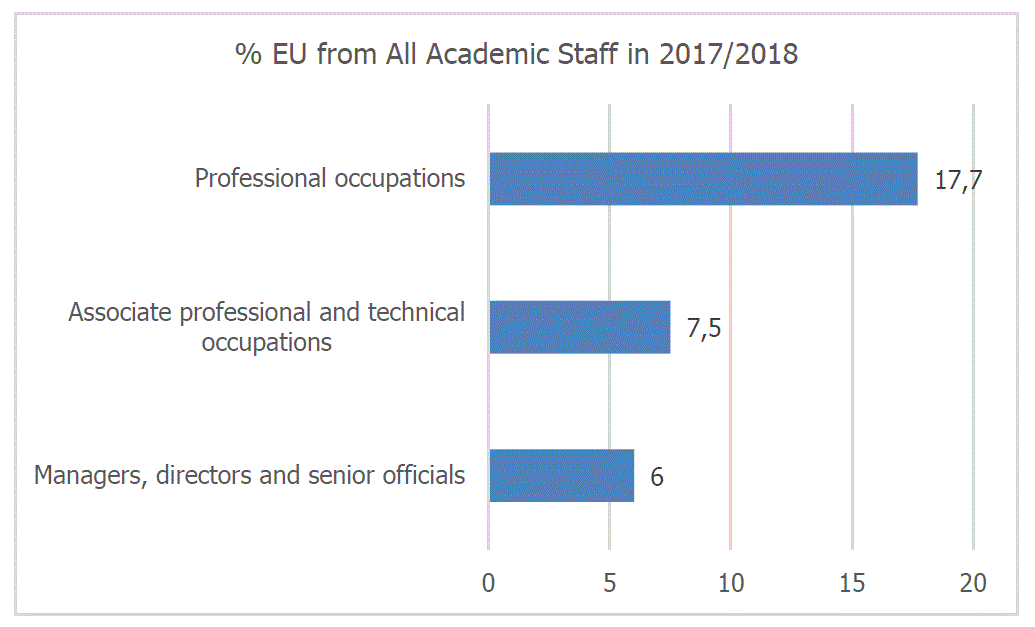

Percentage of European non-academic staff compared to all non-academic staff in British HE in 2017/2018 academic year (HESA, 2019a).
The highest percentage of European professionals working in HE on the non-academic contract is visible in the Elementary positions (9.84%), Sales and customer service occupations (8.01%) and Process, plant and machine operatives (7.38%).
The available data does not provide information, which positions within these sectors were taken by Europeans. However, it is interesting to note, that these positions are usually considered as lower paid jobs, the smallest percentage of available posts occupied by Europeans were Managers, directors and senior officials.

British and European academic staff working at British HE by discipline in 2017/2018 academic year (HESA, 2019c)
While comparing British and European Academic Staff members, it is visible, that in several disciplines the percentage of Europeans in comparison to British colleagues working in the same area is much higher than the percentage of European in comparison to British colleagues working in general under academic contact (25.6%).
These are: Biological, mathematical & physical sciences (39%), Engineering & technology (35%), Humanities & language based studies & archeology (35%).
Slightly above the average are Social studies (27%) and Agriculture, forestry & veterinary science (27%). Typically, European academics have 25.6% of the positions taken by their British colleagues.
However, in STEM areas and Humanities & language based studies & archeology this percentage is much higher. These are the areas, where the potential departure of European researchers might have the biggest impact.

British and European academic staff working at British HE by academic employment function from 2014/2015 till 2017/2018 academic year (HESA, 2019b).
While looking into the chart, it is visible the total number of academics focusing in their work on research is rather stable. However, the number of British researchers is slowly declining and the number of European researchers is steadily growing.
It is also possible to note, that the total number of academics focusing on teaching is slowly growing – both the number of British and European teachers. It is possible to infer, that there is ongoing need for the increased number of teachers which corresponds to the increasing number of students.
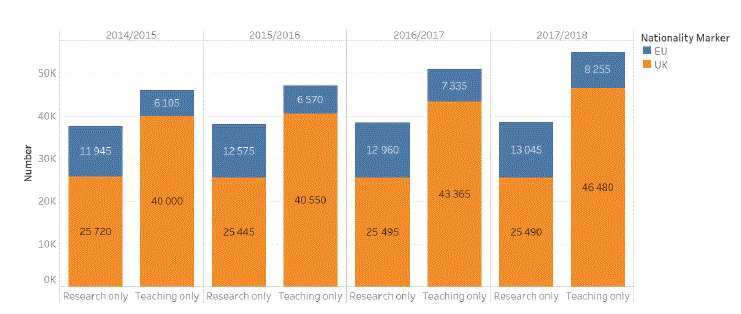
Studies of EU students in UK and British students in EU
HE student enrolments by subject of study in British HE in 2016/2017 academic year (HESA, 2019d)
While looking into this chart, it is possible to observe that biggest number of European students in comparison to their British peers appears in the subjects related to the Business & administrative studies (12.5%), Engineering & technology (11.3%), Mass communications & documentation (10.8%) and Computer science (10.2%).
The smallest percentage of European students in comparison to their British peers appears in Education (2.1%), Subjects allied to medicine (3.2%), Veterinary science (4.4%), Agriculture & related subjects (4.7%) and Medicine & dentistry (4.8%).
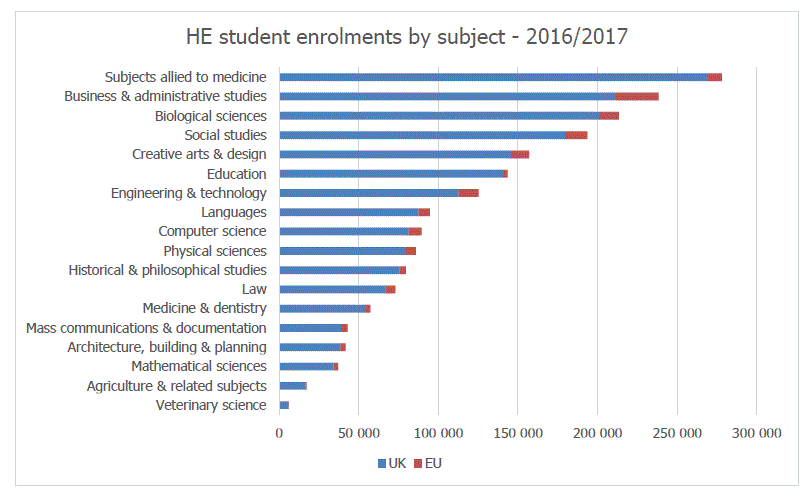
Percentage of European students compared to all students in British HE in 2016/2017 academic year (HESA, 2019d).
It is interesting to compare the data about EU students in relation to the British students, to the percentage of EU students in relation to all students enrolled in 2016/2017 academic year by the discipline. While comparing these two charts it is possible to infer, that there are more European students studying Mass communication & documentation than Non-European ones. Additionally the ratio of European students both in comparison to British students and to All students is very high in the disciplines related to the Computer science, Business & administrative studies and Engineering & technology. Again, the lowest ratio of European of students appears in the Education, Subjects related to medicine, Veterinary science and Medicine & dentistry.
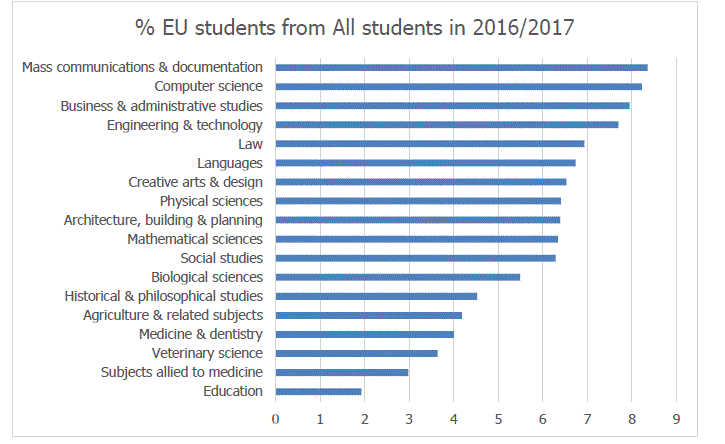
HE student enrolments by subject of study in British HE in 2017/2018 academic year (HESA, 2019d)
One year later, the situation did not change dramatically. Still, the biggest percentage of EU students in comparison to British peers appears in Business & administrative studies (12.7%), Engineering & technology (11.3%), Mass communications & documentation (11.1%) and Computer science (10.7%). The smallest percentage of European students in comparison to their British peers appears in Education (2%) and Subjects allied to medicine (3.2%).
While comparing the data about Europeans to British students from 2017/2018 to All students, it is visible, that in comparison to 2016/2017 academic year, the biggest percentage of Europeans in comparison to All students still appears in Computer science (8.5%), Mass communications & documentation 8.4%), Engineering & technology (7.7%). There was a further drop in Education (1.8%) and Subjects allied to medicine (2.9%)
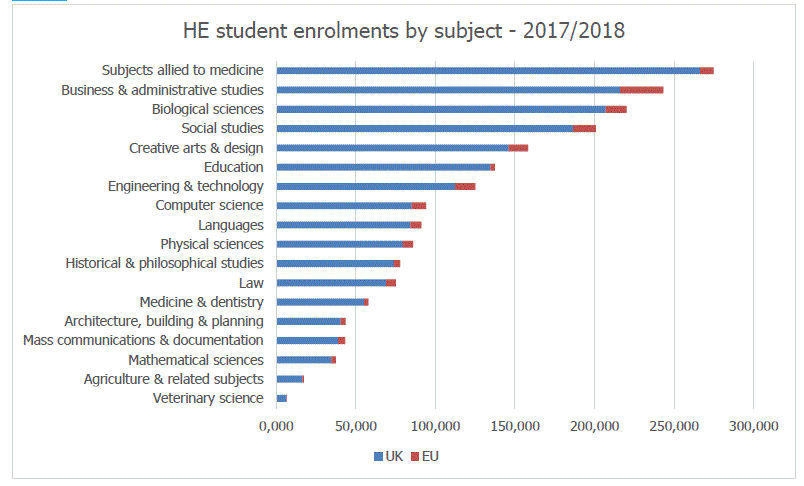
Percentage of European students compared to all students in British HE in 2017/2018 academic year (HESA, 2019d).
In 2017/2018 academic year, there were 2,343,095 students studying in UK. This chart presents the percentage of European students in a comparison to all students (British and non-European). The most popular areas for European students were Computer science (8,52%), Mass communication & documentation (8,39%), Business & administrative studies (7,95%) and Engineering & technology (7,72%).
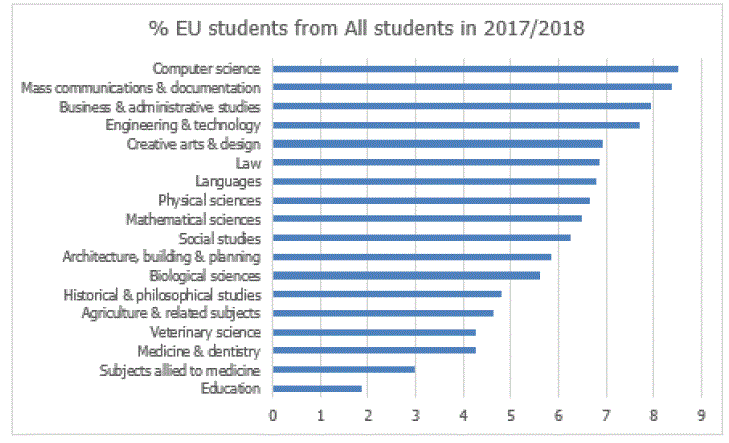
Change in % of European students compared to all students in British HE between 2016/2017 and 2017/2018 academic year (HESA, 2019d).
While comparing 2016/2017 and 2017/2018 academic year, it is visible, that the biggest change in the number of students happened in Veterinary science, Agriculture & related subjects, Computer science, Medicine & dentistry and Creative arts & design. Less persons study education, Architecture, building & planning and Languages.
However, it does not look that the Brexit referendum affected these numbers. The biggest change in the Veterinary sciences and Agriculture & related subjects can be explained by low base number of students.
It is interesting to compare the percentages of EU academics working in the different disciplines in relation to their British colleagues with the percentage of EU students in relation to their British peers by discipline.
The highest percentage of EU teachers in comparison to British teachers appears in Biological, mathematical & physical sciences (39%), Engineering & technology (35%), Humanities & language based studies & archeology (35%). Slightly above the average are Social studies (27%) and Agriculture, forestry & veterinary science (27%).
However, the biggest percentage of EU students in comparison to British peers appears in Business & administrative studies (12.7%), Engineering & technology (11.3%), Mass communications & documentation (11.1%) and Computer science (10.7%). Moreover, there is a very small percentage of EU students in comparison to British students studying Education (2%) and Subjects allied to medicine (3.2%), Medicine & dentistry (5.1%), Veterinary science (5.2%), Agriculture & related subjects (5.3%), Historical & philosophical studies (5.5%).
These numbers only partially, in relation to the STEM classes correspond to each other. However, the subjects related to the humanistic, agriculture and veterinary are not popular among EU students. Surprisingly, subjects related to Medicine, where the percentage of EU teachers to UK teachers is very high are among the ones, where the percentage of EU students is actually very low. It would be interesting to investigate the reason of this and why there is no correlation between European academics and students.
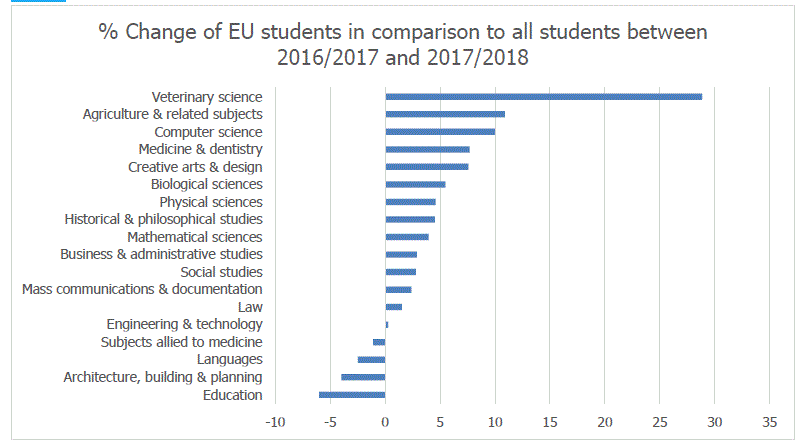
Top 10 EU countries in 2017/2018 academic year for British HE student enrolment (HESA, 2019e).
The majority of European students studying in UK came from the most populated countries such as Italy, France, Germany and Spain. Additionally, there were many students from Greece and Cyprus (European Union) and Central and Eastern European countries such as Romania, Poland and Bulgaria.

British HE student enrolments by domicile in 2014/2015 - 2017/2018 academic years (HESA, 2019e).

Top 10 countries in 2017/2018 academic year for British HE student enrolment (HESA, 2019e).
In 2017/2018 academic school year, it is possible to notice the difference between the number of Chinese students and the students from other countries.
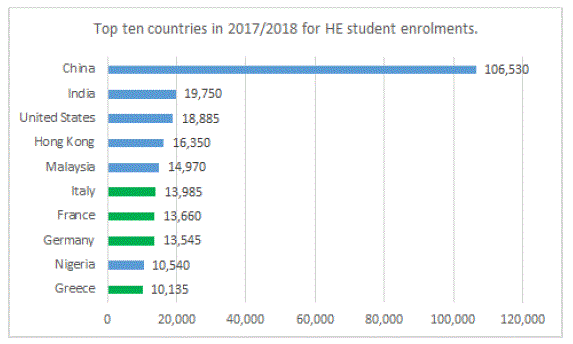
Student exchanges with a focus on Erasmus + program
Outgoing students in UK in 2014/2015 - 2016/2017 within Erasmus + (Erasmus +: creating opportunities for the UK across Europe, n.d.)
In 2014/2015 academic year and 2015/2016 the number of students going abroad was on the same level, however one year later it tripled.

Top 10 host countries for British students from 2014/2015 - 2016/2017 academic year (Erasmus +: creating opportunities for the UK across Europe, n.d.)
Every year, France was the most popular destination. In total, 6,975 students went there on Erasmus exchange. Within 3 academic years, Spain was visited by 6,320 students. Germany was visited by only 3,895 students, Netherlands by 2,191 and Italy by 2,203 students.
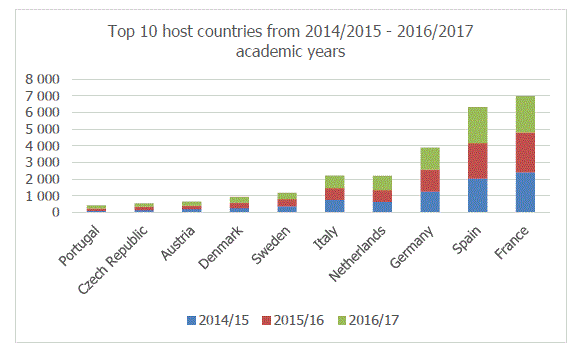
Inbound and outbound mobility within Erasmus + in 2017 (European Commission: Directorate-General for Education, Youth, Sport and Culture, 2018)
Spain was the most popular host country and was visited by 33,155 students, Germany was the second most popular country and was visited by 22,268 students, France was visited by 21,135 students. Germany had the biggest outbound mobility - 32,138 students went to study abroad, from second place had Spain and France. United Kingdom had a visible difference between inbound and outbound mobility, which is visualized on the chart below.

Inbound and outbound mobility within Erasmus + in 2017 (European Commission: Directorate-General for Education, Youth, Sport and Culture, 2018)
UK was popular host country and 18,702 spent there their Erasmus + program. 9,615 British students studied abroad.

Participation in research grants coming from EU funding - Horizon 2020
Horizon 2020: Top 10 countries, which provided and requested contribution (European Commission, 2019a).
Germany provided the biggest contribution tothe European budget and it was followed by UK. However, UK was the first country when taking into account the number of requested funding.

Horizon 2020: Top 10 countries, by eligible proposals (only EU) (European Commission, 2019b).
It is visible, that UK has the highest number of all countries and the difference between the first and second country by the number of proposals is much bigger than the differences between second, third and fourth country.

Participation in research grants coming from EU funding - Structural Funds
Overall, UK had 277 projects within ESIF (2014-2020), which makes 3.7% of all projects within this area. EU supported these projects with EUR 16 448 404 717, UK participated with EUR10 246 430 430. The mean of EU cofinansincing was 65.01%, where the minimum level of EU co-financing was 27% and maximum 100%. Educational & Vocational Training was funded from ESF fund (EUR 1,896,960,740) and EAFRD (EUR 146,495,799) (European Commission (2019d).
Summary of Discussion
The available data allowed to state, that currently there is no visible impact of Brexit. All HE stakeholders – among which teachers and students seem to wait for the final Brexit decisions. Equally, the legislators are preparing for the new situations, but nothing has been decided in this moment. This however does not mean, that the possible “no deal” Brexit will have no impact. UK and EU are interlinked together for last decades. European teachers teach at British universities, European students pursue their degrees using British HE. United Kingdom is a fourth country to which European students come for an study exchange within Erasmus + program. Finally, 11% of research funding within UK comes from EU sources. EU will feel the impact of losing part of the British contributions in its budget. However, it is difficult to state, how missing contributions to the general budget will impact HE financing.
The performed analysis aimed to give a basis for the future research. By understanding current situation, it will be possible to reflect upon potential Brexit impact and relate it to the past. Moreover, this research paper opened up new areas which are pending investigation. Currently, there is no data allowing to estimate how many British teachers work at European institutions. Eurostat gathers data about student mobility in a different way than HESA, which impedes its comparison. The European Union has very strong research basis and aims to compete with other countries in terms of innovation. In the world which is so interlinked as it is today, it is not possible to work and perform research without cooperating with others and Brexit will have an impact on this aspect. This research paper confirms, that four freedoms – freedom of the free movement of people, goods, services and capital are the natural part of the research process and losing them might have a strong impact on HE in UK.